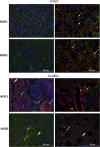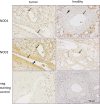NOD1 and NOD2 of the innate immune system is differently expressed in human clear cell renal cell carcinoma, corresponding healthy renal tissue, its vasculature and primary isolated renal tubular epithelial cells
- PMID: 30903318
- PMCID: PMC11810433
- DOI: 10.1007/s00432-019-02901-7
NOD1 and NOD2 of the innate immune system is differently expressed in human clear cell renal cell carcinoma, corresponding healthy renal tissue, its vasculature and primary isolated renal tubular epithelial cells
Abstract
Purpose: NOD1 and NOD2 (nucleotide-binding oligomerization domain)-receptors are intracellular receptors and belong to the family of pattern recognition receptors being present in both human and murine renal tubular cells. Besides, NOD1 has been proved to promote apoptosis, upon its overexpression. Hence, we aimed to investigate NOD1 and NOD2 expression in human clear cell renal cell carcinoma (ccRCC).
Methods: Tumor and corresponding adjacent healthy tissues from 41 patients with histopathological diagnosis of ccRCC as well as primary isolated renal tubular epithelial cells (TECs) and tumor tissue from a murine xenograft model using CAKI-1 ccRCC cells were analyzed.
Results: NOD1 and NOD2 mRNA was constitutively expressed in both tumor and adjacent healthy renal tissue, with NOD1 being significantly lower and in contrast NOD2 significantly higher expressed in tumor tissue compared to healthy tissues. Immunohistochemically, NOD1 was located not only in the cytoplasm, but also in the nucleus in ccRCC tissue whereas NOD2 was solely localized in the cytoplasm in both human ccRCC as well as in the healthy tubular system. Focusing on the vasculature, NOD2 displayed broader expression than NOD1. In primary TECs as well as CAKI-1 cells NOD1 and NOD2 was constitutively expressed and increasable upon LPS stimulation. In the mouse xenograft model, human NOD1 mRNA was significantly higher expressed compared to NOD2. In contrast hereto, we observed a shift towards lower mouse NOD1 compared to NOD2 mRNA expression.
Conclusion: In view of reduced apoptosis-associated NOD1 expression in ccRCC tissue opposed to higher expression of NOD2 in tumor vasculature, inducibility of NOD expression in TECs as well as the detected shift of NOD1 and NOD2 expression in the mouse xenograft model, modulation of NOD receptors might, therefore, provide a molecular therapeutic approach in ccRCC.
Keywords: Clear cell renal cell carcinoma; Innate immunity; Kidney cancer; NLR.
Conflict of interest statement
The authors declare that they have no conflict of interest and that the results presented in this paper have not been published previously in whole or part.
Figures






Similar articles
-
COL6A2 in clear cell renal cell carcinoma: a multifaceted driver of tumor progression, immune evasion, and drug sensitivity.J Transl Med. 2025 Aug 6;23(1):875. doi: 10.1186/s12967-025-06793-9. J Transl Med. 2025. PMID: 40770761 Free PMC article.
-
Multi-omics analysis of zinc finger protein 683 as a prognostic biomarker for immune infiltration in clear cell renal cell carcinoma.BMC Cancer. 2025 Jul 29;25(1):1236. doi: 10.1186/s12885-025-14643-6. BMC Cancer. 2025. PMID: 40730958 Free PMC article.
-
Retinoic acid differently modulates NOD1/NOD2-mediated inflammatory responses in human macrophage subsets.Front Immunol. 2025 Jul 1;16:1609763. doi: 10.3389/fimmu.2025.1609763. eCollection 2025. Front Immunol. 2025. PMID: 40666513 Free PMC article.
-
A Systematic Review and Meta-analysis Comparing the Effectiveness and Adverse Effects of Different Systemic Treatments for Non-clear Cell Renal Cell Carcinoma.Eur Urol. 2017 Mar;71(3):426-436. doi: 10.1016/j.eururo.2016.11.020. Epub 2016 Dec 8. Eur Urol. 2017. PMID: 27939075
-
Targeted therapy for advanced renal cell carcinoma.Cochrane Database Syst Rev. 2008 Apr 16;2008(2):CD006017. doi: 10.1002/14651858.CD006017.pub2. Cochrane Database Syst Rev. 2008. PMID: 18425931 Free PMC article.
Cited by
-
Novel insights into NOD-like receptors in renal diseases.Acta Pharmacol Sin. 2022 Nov;43(11):2789-2806. doi: 10.1038/s41401-022-00886-7. Epub 2022 Apr 1. Acta Pharmacol Sin. 2022. PMID: 35365780 Free PMC article. Review.
-
Silencing lncRNA TUG1 Alleviates LPS-Induced Mouse Hepatocyte Inflammation by Targeting miR-140/TNF.Front Cell Dev Biol. 2021 Feb 11;8:616416. doi: 10.3389/fcell.2020.616416. eCollection 2020. Front Cell Dev Biol. 2021. PMID: 33644034 Free PMC article.
-
A Novel Immune-Related Prognostic Signature for Thyroid Carcinoma.Technol Cancer Res Treat. 2020 Jan-Dec;19:1533033820935860. doi: 10.1177/1533033820935860. Technol Cancer Res Treat. 2020. PMID: 32588760 Free PMC article.
-
Activation of RIPK2-mediated NOD1 signaling promotes proliferation and invasion of ovarian cancer cells via NF-κB pathway.Histochem Cell Biol. 2022 Feb;157(2):173-182. doi: 10.1007/s00418-021-02055-z. Epub 2021 Nov 26. Histochem Cell Biol. 2022. PMID: 34825931
-
Investigation into the Role of Long-Non-Coding RNA MIAT in Leukemia.Noncoding RNA. 2023 Aug 11;9(4):47. doi: 10.3390/ncrna9040047. Noncoding RNA. 2023. PMID: 37624039 Free PMC article.
References
-
- Baer PC, Nockher WA, Haase W, Scherberich JE (1997) Isolation of proximal and distal tubule cells from human kidney by immunomagnetic separation. Kidney Int 52:1321–1331 - PubMed
-
- Bertin J et al (1999) Human CARD4 protein is a novel CED-4/Apaf-1 cell death family member that activates NF-kappaB. J Biol Chem 274:12955–12958 - PubMed
-
- Braunstein MJ, Kucharczyk J, Adams S (2018) Targeting toll-like receptors for cancer therapy. Target Oncol. 10.1007/s11523-018-0589-7 - PubMed
-
- Bray F, Ferlay J, Soerjomataram I, Siegel RL, Torre LA, Jemal A (2018) Global cancer statistics 2018: GLOBOCAN estimates of incidence and mortality worldwide for 36 cancers in 185 countries. Cancer J Clin. 10.3322/caac.21492 - PubMed
MeSH terms
Substances
Grants and funding
LinkOut - more resources
Full Text Sources
Medical

